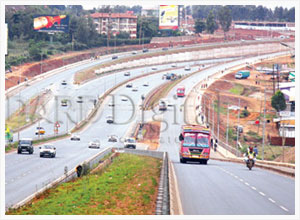 Kenya expects to ride on increased investment in infrastructure, agriculture and newfound wealth in oil and gas to kick-start the economy.
Kenya expects to ride on increased investment in infrastructure, agriculture and newfound wealth in oil and gas to kick-start the economy.
President Uhuru Kenyatta yesterday said under the country’s long-term development plan, Vision 2030, the government seeks to expand and improve infrastructural facilities, agriculture, education and health care. He is forecasting to grow the economy by double-digits and generate one million jobs annually in a growth anchored on agriculture and industrial sectors.
This entails the implementation of programmes in energy, security, science, technology and innovation and also scale up priority sectors such as agriculture, tourism, trade, manufacturing, ICT and oil and mineral resources. “The Kenya Vision 2030 has brought us to the stage where we are laying a robust national economic foundation,” the president said.
Rain-fed agriculture
Major projects in the pipeline include the Lamu Port as well as a major highway connecting the port with Ethiopia and South Sudan. It is also seeking to revamp the century old railway line from Mombasa to Kampala as well as build additional terminal and runway at the Jomo Kenyatta International Airport.
While Kenya’s economic fortunes have been chiefly tied to rain-fed agriculture, the country is eyeing irrigation and a revamp of its industrial sector. Part of the agenda is to commercialise the sector, to help generate revenues for about 70 per cent of the population.
“The transformation of agriculture extends to reducing dependence on rain-fed agriculture by extending area under irrigation, which is set to expand significantly,” the president said during the opening ceremony of the Ready for Take Off: Kenya’s Economic Successes, Prospects and Challenges conference organised by the International Monetary Fund (IMF) and the National Treasury.
One of the government’s ambitious irrigation projects is the 1.2 million acres in Galana, which is expected to help improve food production as well as increase the production of maize and sugar.
This offers Kenya the best route to wean its economy from the volatile rain fed agriculture to become a regional hub for high-value industrial products. “All these ambitious and visionary plans we have, the work and resources we expend will ultimately improve the quality of lives for the people of Kenya.” The president drew the analogy of Kenya’s long distance runners’ quality for discipline as a recipe for the success of the economic growth prospects.
However, he pointed to hindrances such as ballooning wage bill that could slow down the economy. “We are confronted with a swelling public sector wage bill that increasingly challenges fiscal policy,” he noted, adding that this is compounded with a stagnant export market.
On her part, IMF director in charge of African development, Antoinette Sayeh, said Kenya is one of the countries where Africa’s recent progress is evident and where the opportunities for economic growth are manifest.